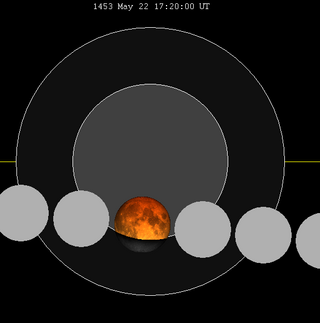| Partial eclipse | |||||||||||||
| Date | 22 May 1453 | ||||||||||||
|---|---|---|---|---|---|---|---|---|---|---|---|---|---|
| Gamma | −0.6067 | ||||||||||||
| Magnitude | 0.7446 | ||||||||||||
| Saros cycle | 102 (56 of 84) | ||||||||||||
| Partiality | 178 minutes, 43 seconds | ||||||||||||
| Penumbral | 315 minutes, 27 seconds | ||||||||||||
| |||||||||||||
A partial lunar eclipse occurred on 22 May 1453.
Observations
It was seen during the Fall of Constantinople (the capture of the capital of the Byzantine Empire), during the siege that lasted from Thursday, 5 April 1453 until Tuesday, 29 May 1453), after which the city fell to the Ottomans. The lunar eclipse was considered to be fulfilling a prophecy for the city's demise, which says a blood moon took place during the eclipse.
Visibility


The partial eclipse was visible from
Africa,
Asia,
Europe and
Oceania.
References
External links
| Partial eclipse | |||||||||||||
| Date | 22 May 1453 | ||||||||||||
|---|---|---|---|---|---|---|---|---|---|---|---|---|---|
| Gamma | −0.6067 | ||||||||||||
| Magnitude | 0.7446 | ||||||||||||
| Saros cycle | 102 (56 of 84) | ||||||||||||
| Partiality | 178 minutes, 43 seconds | ||||||||||||
| Penumbral | 315 minutes, 27 seconds | ||||||||||||
| |||||||||||||
A partial lunar eclipse occurred on 22 May 1453.
Observations
It was seen during the Fall of Constantinople (the capture of the capital of the Byzantine Empire), during the siege that lasted from Thursday, 5 April 1453 until Tuesday, 29 May 1453), after which the city fell to the Ottomans. The lunar eclipse was considered to be fulfilling a prophecy for the city's demise, which says a blood moon took place during the eclipse.
Visibility


The partial eclipse was visible from
Africa,
Asia,
Europe and
Oceania.


